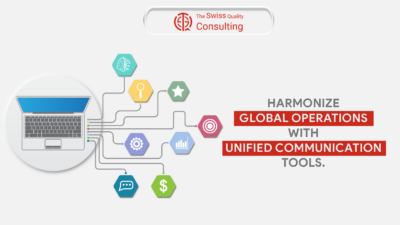Operational Symphony: Unleashing Unified Communication Tools for Global Harmony
In the interconnected world of business, achieving synergy across global operations is paramount for success. This blog explores various ways through which businesses can harmonize global operations with unified communication tools.
As businesses expand globally, the need for seamless communication becomes a critical factor in ensuring operational efficiency. Unified communication tools offer a comprehensive solution, bridging the gaps and fostering collaboration among teams spread across diverse locations.
Understanding Unified Communication Tools
Unified communication tools integrate various communication channels, including voice, video, messaging, and collaboration platforms, into a single cohesive system. This consolidation streamlines communication processes, providing a unified and user-friendly experience for teams operating on a global scale.
Unlocking Ways to Harmonize Global Operations With Unified Communication Tools
Unlocking a new era in workplace efficiency, the benefits of Unified Communication (UC) tools are reshaping the way organizations collaborate and communicate. In this section, we delve into the transformative advantages that UC tools bring to the table, enhancing collaboration, boosting productivity, and providing a streamlined communication experience for businesses navigating the complexities of the modern work environment.
1. Enhanced Collaboration
Unified communication tools break down communication barriers, fostering real-time collaboration among global teams. Whether it’s a video conference, instant messaging, or file sharing, these tools provide a centralized platform for effective teamwork.
2. Improved Productivity
By centralizing communication channels, unified tools eliminate the need for employees to navigate multiple platforms. This streamlining enhances productivity as teams can focus on their tasks without interruptions or the complexity of managing different communication tools.
3. Cost Efficiency
Traditional communication methods, especially in a global context, can be costly. Unified communication tools offer a cost-effective alternative, reducing expenses associated with travel, international calls, and disparate communication solutions.
4. Flexibility and Accessibility
Teams can communicate and collaborate from anywhere in the world with unified communication tools. This flexibility ensures that global operations are not hindered by geographical boundaries, time zones, or physical distances.
Implementing Unified Communication Tools
Navigating the implementation of Unified Communication (UC) tools requires a strategic approach to seamlessly integrate these transformative solutions into existing business structures. In this section, we explore key considerations and actionable steps for implementing UC tools successfully. From conducting a comprehensive needs assessment to ensuring user adoption, discover the practical insights that pave the way for a smooth and effective integration of UC tools within your organization.
1. Comprehensive Needs Assessment
Before implementing unified communication tools, conduct a thorough assessment of the communication needs of your global operations. Consider factors such as the size of teams, preferred communication channels, and existing infrastructure.
2. Integration with Existing Systems
Ensure seamless integration with existing systems and technologies. Unified communication tools should complement and enhance the current infrastructure, providing a smooth transition for teams accustomed to different communication methods.
3. User Training and Adoption
Successful implementation relies on user adoption. Provide comprehensive training to teams to familiarize them with the features and functionalities of the unified communication tools. Encourage active participation to maximize the benefits.
4. Security Considerations
Global operations often involve sensitive information. Prioritize the security features of unified communication tools, ensuring that data is encrypted, and access is restricted to authorized personnel. Compliance with data protection regulations is essential.
Challenges and Considerations Involved to Harmonize Global Operations With Unified Communication Tools
While the benefits are significant, global harmonization through unified communication tools comes with challenges:
1. Cultural Differences
Understanding and respecting cultural nuances is crucial for effective communication. Unified tools should facilitate cultural awareness and sensitivity among global teams.
2. Connectivity Issues
Global operations may face connectivity challenges, impacting the effectiveness of unified communication tools. Implement redundancy measures and alternative communication channels to address potential issues.
3. Scalability
Choose unified communication tools that can scale with the growing needs of your global operations. Ensure that the chosen solution can accommodate an increasing number of users and evolving communication requirements.
Harmonize Global Operations With Unified Communication Tools: A Unified Perspective
As organizations embrace the era of interconnectedness, the harmonization of global operations through unified communication tools is poised to define the future of collaboration and efficiency.
Conclusion
In conclusion, the strategic adoption of unified communication tools empowers organizations to harmonize global operations, fostering collaboration, improving productivity, and driving cost efficiency. Embrace the transformative potential of these tools for a connected and unified future.
#UnifiedCommunication #GlobalOperations #CollaborationTools #BusinessConnectivity #DigitalTransformation #OperationalEfficiency























